Table of Contents
|
The First Village Council
On Monday, January 6, 1873, voters of the newly
incorporated village of
Richmond Hill went to
the polls to elect their first municipal council - a reeve and four
councillors. The results as announced by the
York Herald were:
5
| For Reeve |
|---|
| Abraham
Law |
56 |
| Andrew
McNair |
47 |
| Dr. John
Duncumb |
5 |
| Councillors |
|---|
| William
Warren |
98 |
| Jacob
Brillinger |
83 |
| William
Powell |
77 |
| David
Hopkins |
62 |
| James
Freek |
58 |
| J.R.
Arnold |
42 |
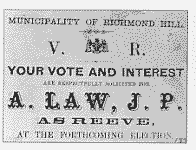 |
| Abraham Law
solicits votes for reeve in
Richmond Hill's
first municipal election. |
The five successful candidates represented a combination
of
Yonge Street business
interests and agricultural concerns -
Law owned a tannery
and
Hopkins ran a
general store, while
Warren,Brillinger, and
Powell were
farmers. On January 20, promptly at 12:00 noon, they began their first meeting
in the
Division Court
Room, located in the
Robin Hood
Hotel. Regular monthly meetings, supplemented by occasional special
meetings, became the norm.
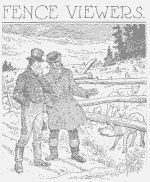 |
|
Municipal "fence viewers," a remnant of pioneer Upper
Canada, were still being appointed in the newly incorporated village of
Richmond Hill in
1873.
C.W. Jefferys,The Picture Gallery of Canadian
History,Ryerson Press |
Civic appointments dominated the agenda of the first
meeting as friends of the council members waited anxiously for patronage jobs.
Postmaster
Matthew Teefy was
named village clerk and treasurer, a choice position he held for the next
thirty-one years. Additional 1873 council appointees included the following
citizens:
- George A.
Barnard and
Robert Law (the
reeve's son) as auditors
- Dennis O'Brien
as assessor
- John Brown as
licence inspector
- John Velie (owner
of the hotel where council met) as pound keeper
- Benjamin
Davidson as overseer of highways
- Frederick
Crawford as fire and nuisance officer
- Robert
Robinson,James Freek, and
John
Arnold as fence viewers
- James Daniels
as collector of dog taxes
Subsequent meetings saw a succession of bylaws
adopted, as council hammered out its role as an arbiter of community life:
- February: Determined conditions for tavern and
shop licences.
- March: Decided on standards for licensing
"exhibitions of Waxworks & Menageries & Circuses."
- April: Passed a "Public Nuisances" bylaw which
set terms for snow, ice, and dirt removal.
- May: Gave a pound keeper authority to
"restrain and regulate the running at large of any animals or poultry."
- June: Authorized a survey of village
boundaries.
(Councillors took July and August off.)
- September: Determined assessments for county,
village, and school purposes.
- October: Voted to impose a dog tax.
- November: Amended the Public Nuisances bylaw
of the previous April.
- December: Made arrangements for the annual
civic election.
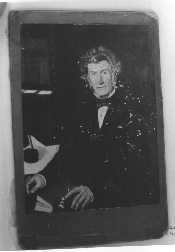 |
| Abraham Law,
first reeve of
Richmond Hill,
1873. |
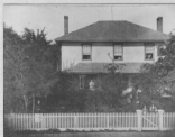 |
| "
Richmond Villa,"
home of the
Abraham Law
family, on the northwest corner of Yonge and
Richmond
streets, built about 1853.
Mrs.
Elizabeth (Klinck) Lawis pictured on the verandah. |
But the major issue facing
Richmond Hill's first
council was the building of a new
high
school. Increased enrolment was straining the capacity of the old
grammar
school erected alongside the
common
school twenty years earlier. Further increases seemed likely, since
provincial legislation of 1871 brought secondary education more closely under
public control and began shifting the financial burden from private tuition
fees to public tax monies.
(Under new regulations, the
Richmond Hill
"Grammar" School became
Richmond Hill
"High" School).
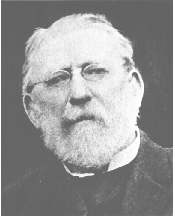 |
| Matthew Teefy
1822-1911 |
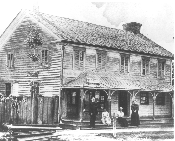 |
| Matthew Teefy,
longtime village postmaster and secretary-treasurer, pictured with his three
daughters on the front porch of the
Richmond
Hill Post Office. |
Original plans for a new
high
school structure were apparently quite ambitious - a $10,000 "large and
magnificent building" which the
York Herald quickly
dubbed a "castle."
6 Fortunately, the more cautious trustees
prevailed, and the school board settled for a $3,170 building, of which just
$1,170 had to be raised from the high school district. But the financial
picture changed when the
York County
Council reduced the boundaries of the high school district to coincide
with the area of the newly incorporated village.
Richmond Hill
residents interpreted that move as showing an anti-education or anti-urban bias
on the part of the county. Whatever the explanation, it severely reduced the
educational tax base and placed the responsibility for financing the new
high
school totally on the village. After public meetings, legal advice, and
much soul searching,
Richmond Hill council
decided to raise the money for the school board through a special levy, which
allowed high school students to move into their new building in November
1873.
The
high
school's heavy debt probably discouraged council from spending much in
other areas that first year. Only $201.69 was spent on street improvements, for
example, in all of 1873. Yet gradually, through its first decade of existence,
the municipal council carved out a more active role in village life. We can get
some sense of the council's activities by looking at minutes of their monthly
meetings:
- Building and repairing
sidewalks: board or "plank" walkways two metres wide along
Yonge Street and
one metre wide on side streets.
- Opening new roadways, such as
Trench Street, a
north-south connection between
Richmond and
Mill streets in the
western part of the village.
- Purchasing second-hand
gas-fired street lamps at four dollars each, from the Village of Yorkville, for
the illumination of
Yonge
Street.
- Providing short-term, limited financial assistance for
"indigent persons," for the "aged and infirm," for tramps and for destitute
widows.
7
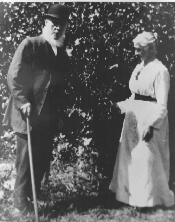 |
| William and
Christina (Whelpton) Harrison.
The community's first historian,
William
Harrison was
Richmond Hill's
second reeve in 1874. |
In spite of decisions like these,
Richmond Hill's
municipal government remained a small operation through the decade of the
1870s. By 1877, the village's population stood at just 659 persons, 151 of whom
were ratepayers. (That year's head count also turned up 67 cattle, 45 sheep, 80
hogs, 105 horses, and 41 dogs residing inside village limits!) A real estate
assessment of $128,335.00 produced $1,667.00 in municipal taxes and $1,060 for
school purposes. Expenses included $365.00 for municipal salaries and $287.00
for roads and bridges.
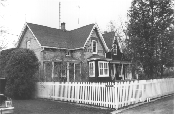 |
| A residence built and put up for
sale in 1885 by
William
Harrison at
17 Elizabeth
Street North. |
The council's significance was further reduced as the
initial euphoria of incorporation shifted into a kind of public apathy toward
municipal affairs. "The great trouble in this village," pronounced the
The Liberal in 1879, "appears to be that the
inhabitants take but very little interest in the doings of the Council or in
the election of members." In an attempt to rouse some interest, the editor
produced a lengthy list of prominent names as potential candidates for council
elections. "Let them all come out, and we'll have an interesting election day!"
8
Still, council seats were
filled, business was transacted, and accomplishments recorded. After seventeen
years of incorporation, noted village historian
William Harrison
in 1889,
Richmond Hill council
had laid sidewalks along principal streets, improved the condition of those
roads, acquired
park land, provided a
well-trained
volunteer fire
brigade, and hired a custodian of "perambulating nuisances."
Notes
5.
Ibid.,
January 10, 1873.
6.
Ibid.,
June 27, 1873.
7.
George W.J. Duncan,"Social Welfare in 1870's Richmond
Hill," Richmond Hill Public Library, Local History
Collection.
8.
The Liberal,December 25,
1879.
Previous
Next
Copyright © Richmond Hill Public Library Board, 1991
|

